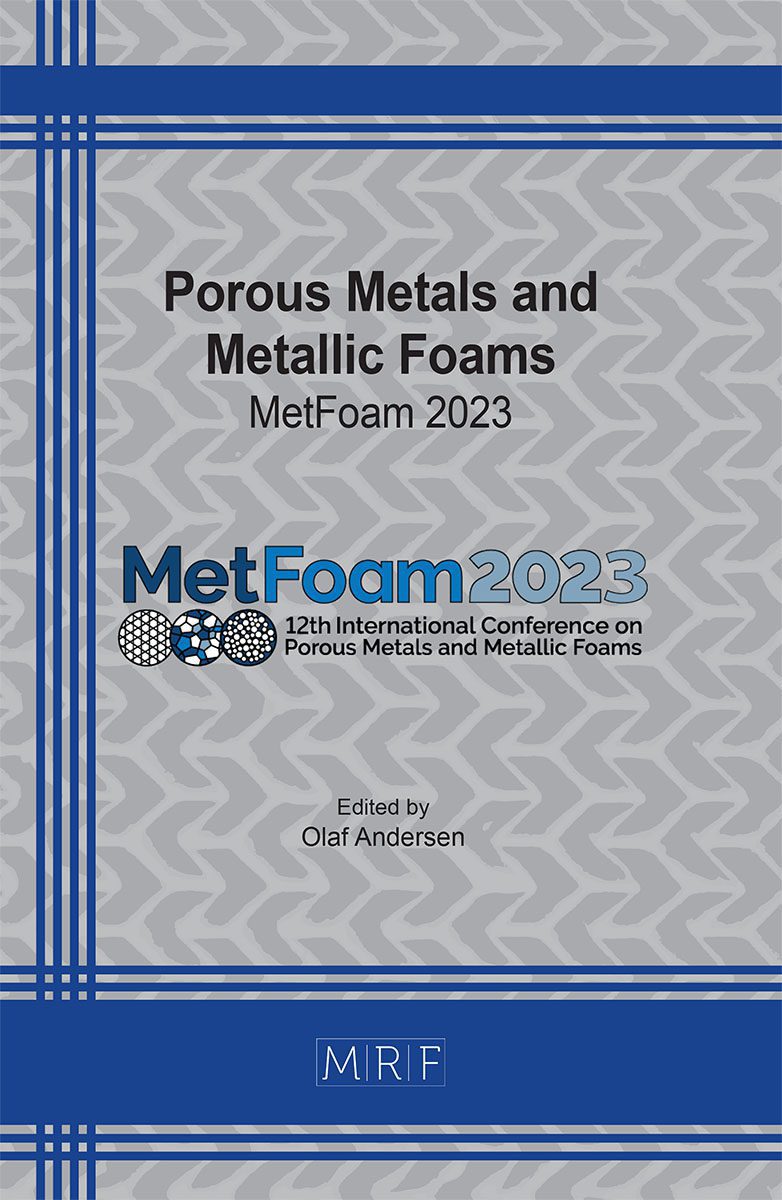Analytical Determination of the Geometrical Properties of Open-Celled Metal Foams Under Compression
Esmari Maré, Sonia Woudberg
download PDFAbstract. Several studies in the literature have been devoted to the permeability prediction of metal foams, including that involving the Representative Unit Cell (RUC) model. The RUC modelling approach is an attractive modelling method due to the simple rectangular geometry, as well as its satisfying performance in comparison to other models and experimental data as proven elsewhere in the literature for porous media. The subject of compression of metal foams has been addressed elsewhere in the literature, but this study is the first to involve an all-inclusive analytical model where both streamwise and transverse compression are accounted for. The Darcy and Forchheimer permeability coefficients of the compressed foam (or three-strut) RUC model are presented. Furthermore, a geometric approach requiring measured geometric parameters and a combined geometric-kinetic approach involving measured permeability coefficients are included for determining the specific surface area. Geometric parameters required to determine the permeability and specific surface area predictions using the compressed foam RUC model include the uncompressed porosity, pore dimension and strut diameter, as well as the compression factor. The model is evaluated through comparison with available experimental data and empirical models obtained from the literature for compressed metal foams. The compressed RUC model predictions produce expected tendencies of geometrical parameters of metal foams under compression and the comparison with experimental data reveal satisfactory results.
Keywords
Metal Foams, Permeability, Specific Surface Area, Compression, Darcy, Forchheimer
Published online 2/25/2024, 10 pages
Copyright © 2024 by the author(s)
Published under license by Materials Research Forum LLC., Millersville PA, USA
Citation: Esmari Maré, Sonia Woudberg, Analytical Determination of the Geometrical Properties of Open-Celled Metal Foams Under Compression, Materials Research Proceedings, Vol. 39, pp 32-41, 2024
DOI: https://doi.org/10.21741/9781644903094-5
The article was published as article 5 of the book Porous Metals and Metallic Foams
![]() Content from this work may be used under the terms of the Creative Commons Attribution 3.0 license. Any further distribution of this work must maintain attribution to the author(s) and the title of the work, journal citation and DOI.
Content from this work may be used under the terms of the Creative Commons Attribution 3.0 license. Any further distribution of this work must maintain attribution to the author(s) and the title of the work, journal citation and DOI.
References
[1] B.V. Antohe, J.L. Lage, D.C. Price, R.M. Weber, Experimental determination of permeability and inertia coefficients of mechanically compressed aluminum porous matrices, ASME. J. Fluids Eng. Vol. 119(2) (1997) 404-412. https://doi.org/10.1115/1.2819148
[2] N. Dukhan, R. Picón-Feliciano, Á.R. Álvarez-Hernández, Air flow through compressed and uncompressed aluminum foam: measurements and correlations, ASME. J. Fluids Eng. 128(5) (2006) 1004-1012. https://doi.org/10.1115/1.2236132
[3] S. Woudberg, M.C. van Heyningen, L. Le Coq, J. Legrand, J.P. Du Plessis, Analytical determination of the effect of compression on the permeability of fibrous porous media, Chem. Eng. Sci. 112 (2014) 108-115. https://doi.org/10.1016/j.ces.2014.03.013
[4] S. Woudberg, E. Maré, M.C. van Heyningen, F. Theron, L. Le Coq, Predicting the permeability and specific surface area of compressed and uncompressed fibrous media including the Klinkenberg effect, Powder Technol. 377 (2021) 488-505. https://doi.org/10.1016/j.powtec.2020.08.081.
[5] S. Hong, Y. Jung, R. Yen, H.F. Chan, K.W. Leong, G.A. Truskey, X. Zhao, Magnetoactive sponges for dynamic control of microfluidic flow patters in microphysiological systems, Lab Chip 14(3) (2014) 514-521. http://dx.doi.org/10.1039/C3LC51076J
[6] K. Boomsma, D. Poulikakos, The effects of compression and pore size variations on the liquid flow characteristics in metal foams, ASME. J. Fluids Eng. 124(1) (2002) 263-272. https://doi.org/10.1115/1.1429637
[7] J. Hwang, G. Hwang, R. Yeh, C. Chao, Measurement of interstitial convective heat transfer and frictional drag for flow across metal foams, ASME. J. Heat Transfer 124(1) 120-129. http://doi.org/10.1115/1.1416690
[8] M.A. Dawson, J.T. Germaine, L.J. Gibson, Permeability of open-cell foams under compressive strain, Int J. Solids Struct. 44(16) (2007) 5133-5145. https://doi.org/10.1016/j.ijsolstr.2006.12.025
[9] M.C. van Heyningen, Investigating the effect of compression on the permeability of fibrous porous media, MSc Thesis, Stellenbosch University, South Africa, 2014.
[10] S. Woudberg, Permeability prediction of an analytical pore-scale model for layered and isotropic fibrous porous media, Chem. Eng. Sci. 164 (2017) 232-245. https://doi.org/10.1016/j.ces.2017.01.061
[11] S. Woudberg, J.P. Du Plessis, An analytical Ergun-type equation for porous foams, Chem. Eng. Sci. 148 (2016) 44-54. https://doi.org/10.1016/j.ces.2016.03.013
[12] N. Dukhan, Correlations for the pressure drop for flow through metal foam, Exp Fluids 41 (2006) 665-672. https://doi.org/10.1007/s00348-006-0194-x
[13] S. Woudberg, Investigation of the effect of compression on a soft fibrous porous medium, Computational Methods in Multiphase Flow VII 79, 2013, pp.351.
[14] H.D. Akaydin, A. Pierides, S. Weinbaum, Y. Andreopoulos, Permeability of soft porous media under one-dimensional compaction, Chem. Eng. Sci. 66(1) (2011) 1-14. https://doi.org/10.1016/j.ces.2010.09.017































